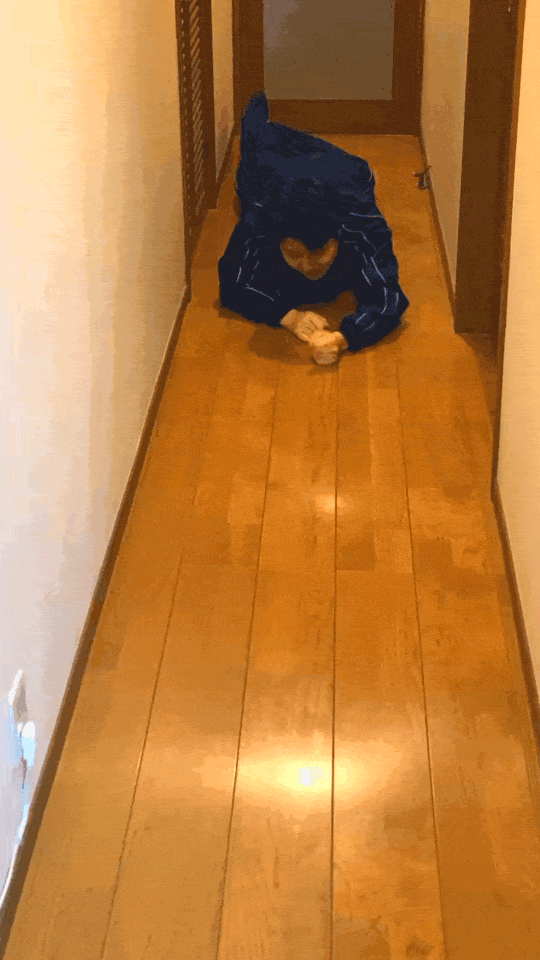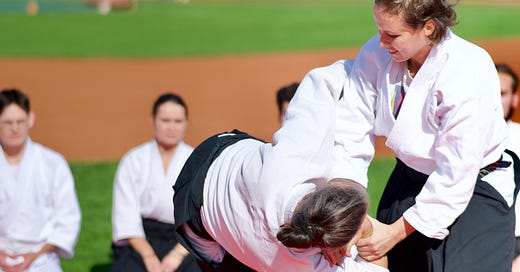Crawling in Aikido? Seriously?
Improving Movement Quality for Aikido Techniques, Ukemi, and Life
I received a lot of feedback on the previous article about (Lack of) Physical Literacy in Aikido Practice—thank you! Your encouraging, inspiring, and curious comments, as well as some doubts, have motivated me to explore the topic further.
I’ll continue with the topic and make it clear what I mean by the development of basic motor skills and how they are beneficial for learning and practicing Aikido techniques.
This isn’t about 'conditioning' or physical fitness!
When I talk about 'physical literacy' or 'basic motor skills,' I mean developing the quality of movement—the body and brain's ability to learn, coordinate, and execute actions.
These articles aren’t about building strength, stamina, or joint mobility, nor do I suggest filling Aikido classes with push-ups or endurance drills.
The goal of “physical literacy” is to develop the ability to see a teacher's Aikido technique and translate it into a natural, efficient, and healthy movement with a partner.
The better we move, the better our Aikido technique and ukemi are.
But everybody can watch and move, right?
Imagine this: if someone can’t do one proper squat by him/herself (due to lack of mobility or coordination), how can we expect that person to do some more complicated lowering hips in an Aikido technique with a partner?
So many people are coming to our dojos who really don’t know that hip joints can move in different directions and they have long forgotten when it was the last time they did a squat. Even simple movements are a challenge for them.
Moreover, someone who hasn’t experienced a variety of movements often struggles to perceive what a teacher is demonstrating—this is called “kinesthetic blindness.”1 It’s that familiar moment when students can’t replicate what you just showed them.
Anyway, forcing people to do 50 squats each class - wouldn’t solve our situation with the quality of movement or “kinesthetic awareness”, it might even make things worse.
Before we ask our students to do koshi nage or lowering hips in uke’s dynamic work, we should provide some preparational exercises that teach their bodies and brains that hips can move naturally and that lowering hips is possible.
And here the knowledge of “basic motor skills” and exercises developing them can be pretty handy.
Should we become animals?
We do many “basic motor skills” exercises in our dojo to prepare people for more complex Aikido movements. Some of them we call “animal alphabet”2 and we do them in many variations and games with all age groups, beginners and advanced.
They’re not new to martial arts training, Gakku Homma mentioned in one of his books3 that they were doing something like that in Judo in the 1960s in Japan. So animal exercises aren’t complete blasphemy in Japanese martial arts.
These animal exercises often come from movement development patterns that babies use to teach their bodies how to move. Nowadays they are used in physiotherapy and also in many martial disciplines like BJJ, Systema, MMA… mostly due to benefits for natural human locomotion.
But crawling in Aikido? Isn’t it too much?
One important “basic motor skills” exercise is crawling4. I deliberately chose it as an example because it looks like anything but Aikido movements. It’s seemingly a world apart from what we do in Aikido and yet soon I’ll show how useful it can be for us.
Today, general physical literacy is so limited that some adults join Aikido unable to crawl—even if they’ve spent years bodybuilding, practicing yoga, or running5. Sometimes their attempts at crawling look like this:

I mean: crawling is one of the most basic movement skills. If someone can’t coordinate four limbs in a simple crawling pattern, how can we expect them to perform complex movements like irimi nage?
The video demonstrates key features of crawling, alternating as follows:
Initial Position: The torso stays low, with the belly close to the ground. The right hip is in external rotation with the knee bent (the right hip is “open”), while the left leg remains extended, the hip in a neutral position, and the knee pointing downward (the left hip is “closed”).
Propulsion: The right foot presses into the ground, finding support through the big toe. The right leg pushes against the ground, extending at the knee and moving the hip into internal rotation (the right hip is “closing”). This movement propels the torso forward. During this phase, the belly should remain close to the ground, sliding forward without lifting. When the leg is fully extended, the hip may rotate slightly further inward.
Transition: This internal rotation of the right hip triggers the external rotation of the left hip as the left knee begins to bend (the left hip is “opening”).
There are two important points to keep:
Keep the belly sliding close to the ground.
Move opposite limbs simultaneously (e.g., left leg is pushing and right arm is pulling the body forward).
You can slow down to observe these details.
Of course, you can object: “But there’s almost no movement in Aikido that resembles this crawling! For what should we move like this?”
Benefits of crawling in Aikido
General coordination
Crawling involves cross-lateral movement, where opposite limbs (e.g., right arm and left leg) move together. This pattern connects the brain’s left and right hemispheres, improving coordination and the ability to execute complex movements. Helping children or adults rediscover these connections can significantly enhance their overall movement.
“Core” (ie. hara) activation
Crawling activates and stabilizes the core, including the abdominal muscles, back extensors, and pelvic floor. This strength lays the foundation for efficient and injury-free movement.
Ukemi
You probably noticed that when standing up from mae or ushiro ukemi, one knee opens to the side while the other points forward—just like in crawling.
We even alternate opening and closing of hips in the same fashion as in crawling in this common Aikido exercise:
If people cannot open their hips like this, they can have all kinds of trouble with standing from Aikido rolls.
Shikko (walking on the knees)
Crawling requires the opening and closing of the hip joints (one knee aiming forward while the other opens to the side) and it’s the similar opening and closing of hip joints, that is required by suwari waza shikko (walking on knees)6.
If we do shikko without the ability to open and close our hips, we tend to bump our knees into tatami, which isn’t very good for them.
When I was teaching about this connection in France, one children’s teacher told me that they have a boy who crawls faster than walks… and guess what? His shikko was fantastically fluent, too.
Pivoting (tai sabaki)
The hips, knees and ankles are dynamically engaged during crawling. This creates both stability (through weight-bearing) and mobility (through controlled movement), which are essential for advanced skills or pivoting.
So crawling can bring some mobility and stability into our footwork in tachi waza.
Integrity of upper body
I didn’t mention it in the crawling description but notice, what arms are doing in my video. An arm extends forward and then flexes and pulls the torso towards it. In this movement, the elbow becomes actively connected to the waist and hips, which is a very common position in Aikido (shoulder down and elbow “connected” with lower ribs)7.
Having fun
Crawling feels playful and even a bit childish compared to the seriousness of Aikido keiko. Children love it, and adults can use it to rediscover the joy of natural movement. It also taps into our innate desire to move, explore, and overcome challenges—key motivators for learning.
There are many more benefits (improving proprioception and body awareness, challenges to the vestibular system, the spinal movement…) but I guess this is enough to see how much can simple crawling bring to our Aikido practice.
And it’s only one of many exercises that we can use to improve our movement: techniques, attacks, or ukemi.
You want to try it?
I often include animal exercises after warm-up and before ukemi drills. Start small—8–12 meters of crawling per class—and repeat it regularly over a few weeks. This approach lets you identify challenges, explore the movement, and track improvements.
Continually you can combine it with eg. shikko to show connections and help students enjoy greater freedom in suwari waza movement. And once you feel that everybody can somehow crawl, it’s time to play with some other animal.
Is that interesting topic for you? Should we cover also some other “basic motor skills” exercises? What would be useful? Let us know in the comments.
The following article about “physical literacy” in Aikido will be about movement analysis - how little we use it and how much we need it. Stay tuned!
Related articles
Read more articles from the cycle Movement Development in Aikido
"Kinesthetic blindness," or the inability to perceive and replicate movement accurately, can hinder students' progress.
During lockdowns in 2020 we did some videos of basic animals for our students so that they could practice them at home. The videos are rather obsolete but as an example, they’re still fine. You can find them on our YouTube.
Children and the Martial Arts: An Aikido Point of View (Homma, Gakku), page 32
In this text, by crawling I mean this movement: “Crawling, a pattern of prone locomotion in which the abdomen is in contact with the surface of support.” ~ definition from Encyclopedia Britannica
It’s not only about beginners. When I lead seminars for Aikido teachers (3-5 dan) and show them how they can teach some basic motor skill exercises in their dojos, many of them can’t coordinate their limbs in animal stuff for little children. Crawling and other animals can be interesting even for advanced Aikidoka… :)
While in both forward crawling and shikko mae hips are opening and closing, there’s an important difference. In crawling, the leg pushing the ground is associated with hip closure, while in shikko, the forward movement occurs through the leg that is opening the hip.
If you noticed this difference, congratulations, your biomechanical analysis is very good!
Google “shoulder girdle stability” for further investigation.





I can see in my classes that crawling is difficult for quite a few of the children. And I was surprised how much they improved when we started to do it regularly.
I practice all animals with the childrens. I think it's foundational. Development of coordination ability is essential at any age. But when you say it is not about conditioning I do not agree. Today's aikido has a lot of problems including a vast majority of practicioners completely out of shape. I'm referring to not only students but teachers also. It's not about being young, beautiful and fit forever, as the modern fitness industry wants to fool us, but being adequate and have a dignity as a martial artist at any age. So I invite you to extend the reflection on the teme :"Is that a problem? And what's a good way to improve? Can an improvement in physical condition make a better aikidoka?"
Thank you for your job.